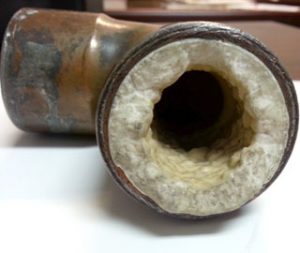WHAT IS HARD WATER?
Water is considered “hard” when your Portsmouth water contains higher levels of dissolved calcium and magnesium. Hard water makes cleaning clothes more difficult, creates streaking on dishes and glasses, and makes cleaning your hair and skin well a challenge. Hard water can also damage your home’s piping distribution system if not corrected. Hard water makes it hard to clean.There are high efficiency water softening solutions that will condition your water by removing these hard water minerals through the proven ion exchange water softening process. Compare your water test results to the following chart:
While symptoms of water quality issues such as bad odors & taste, staining of laundry, bathroom fixtures, etc. are indicators of problems, the preferred starting point is to get a water test to identify the minerals or contaminants in the water and at what quantity they exist. This will lead to an effective system recommendation and route to providing your home with excellent water quality. While certain minerals & contaminants can be tested on-site (iron, hardness, pH, total dissolved solids), health threat items like radon in water, arsenic in water, nitrates, bacteria and others should be properly sampled and brought to a certified laboratory for testing that requires specialized equipment.
WATER SOFTENER SYSTEMS
A water softener is a type of whole house water filtration system that is designed for removing hard water minerals (magnesium & calcium) as well as dissolved iron and manganese from the water. For water with high levels of iron or manganese (“the stainers”), an “Up-flow” water softener is recommended to prevent mineral build-up in the bottom of the water softener. Also, high efficiency water softeners that are more efficient with both water and salt usage are preferred.
WHOLE HOUSE WATER FILTRATION FOR OTHER CONTAMINANTS
Other contaminants found in the well water of Portsmouth and the New England region include Radon and Arsenic. A water softener will not remove these health threat contaminants. Radon in water is safely removed with an aeration system that agitates the incoming well water, releasing the gas from the water into a sealed chamber for further safe venting outside of the home.
Arsenic in water can be removed at the point of entry into the home by installing tanks filled with arsenic specific resin that captures the arsenic before it can get into the home’s water supply. Point of use systems for drinking water can use reverse osmosis technology to effectively remove arsenic as well. Speak to a water treatment professional to decide which system is right for you.
In addition to the above systems described, there are many other types of systems to remove bad tastes & odors, sediment and other objectionable minerals and contaminants in the water. A water test and analysis will lead to the best approach. For more information on bad odors & taste issues, go to the link at https://h2ocare.com/bad-odor-taste-water/.








